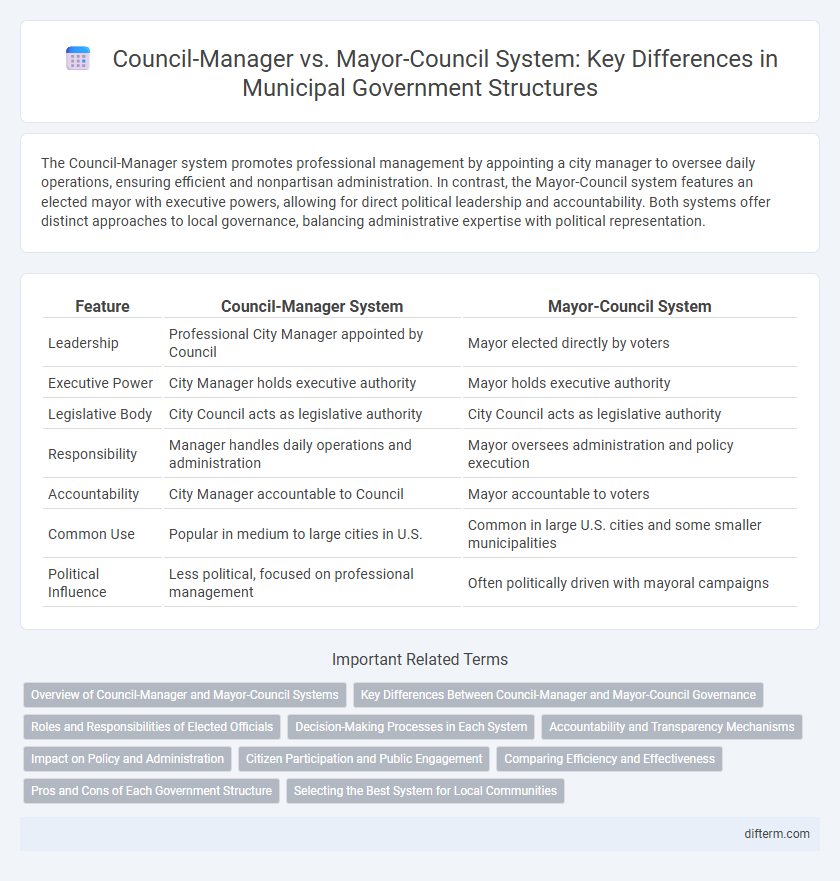The Council-Manager system promotes professional management by appointing a city manager to oversee daily operations, ensuring efficient and nonpartisan administration. In contrast, the Mayor-Council system features an elected mayor with executive powers, allowing for direct political leadership and accountability. Both systems offer distinct approaches to local governance, balancing administrative expertise with political representation.
Table of Comparison
| Feature | Council-Manager System | Mayor-Council System |
|---|---|---|
| Leadership | Professional City Manager appointed by Council | Mayor elected directly by voters |
| Executive Power | City Manager holds executive authority | Mayor holds executive authority |
| Legislative Body | City Council acts as legislative authority | City Council acts as legislative authority |
| Responsibility | Manager handles daily operations and administration | Mayor oversees administration and policy execution |
| Accountability | City Manager accountable to Council | Mayor accountable to voters |
| Common Use | Popular in medium to large cities in U.S. | Common in large U.S. cities and some smaller municipalities |
| Political Influence | Less political, focused on professional management | Often politically driven with mayoral campaigns |
Overview of Council-Manager and Mayor-Council Systems
The Council-Manager system features an elected council responsible for legislative functions and a professional city manager appointed to handle administrative operations, emphasizing expertise and efficiency in municipal management. In contrast, the Mayor-Council system divides power between an elected mayor, who often holds executive authority, and a council responsible for legislative duties, allowing direct political leadership and accountability. Both systems shape local governance by balancing political representation with operational management, affecting policy implementation and public service delivery.
Key Differences Between Council-Manager and Mayor-Council Governance
The Council-Manager system features a professionally appointed city manager responsible for administrative operations, while the elected council focuses on legislative functions, prioritizing expertise and efficiency in governance. In contrast, the Mayor-Council system vests executive authority in an elected mayor who directly oversees city departments, emphasizing political leadership and public accountability. These differences impact decision-making processes, with the Council-Manager model favoring bureaucratic management and the Mayor-Council model highlighting political representation and policymaking.
Roles and Responsibilities of Elected Officials
In the Council-Manager system, elected officials primarily serve legislative functions by setting policies and goals while a professionally appointed city manager handles administrative operations and daily management. In contrast, the Mayor-Council system vests executive authority in an elected mayor, who oversees city departments and enforces laws, while the council functions as the legislative body. The distribution of responsibilities in each system influences accountability, administrative efficiency, and the balance of political power within local government.
Decision-Making Processes in Each System
The Council-Manager system centralizes decision-making authority in a professional city manager appointed by the elected council, ensuring administrative expertise and consistent policy execution. In contrast, the Mayor-Council system vests executive power directly in an elected mayor, who holds significant control over budgeting and administrative appointments, leading to more politicized decision-making. These structural differences influence the responsiveness and efficiency of local government operations.
Accountability and Transparency Mechanisms
The Council-Manager system enhances accountability through a professional city manager appointed by the council, ensuring clear delineation between policy-making and administration, which promotes transparent operations and reduces political influence in daily management. In contrast, the Mayor-Council system centralizes executive power in an elected mayor, increasing direct electoral accountability but potentially reducing transparency due to concentrated authority and political considerations influencing administrative decisions. Both systems implement transparency mechanisms such as public meetings, open records laws, and budget disclosures, but the Council-Manager model typically emphasizes procedural transparency via bureaucratic oversight, while the Mayor-Council model relies more on political accountability through voter engagement.
Impact on Policy and Administration
The Council-Manager system centralizes administrative authority in a professional city manager, promoting efficient policy implementation and reducing political influence in day-to-day operations. In contrast, the Mayor-Council system vests executive power in an elected mayor, allowing for stronger political leadership and direct public accountability in shaping policy. These structural differences impact policy responsiveness, administrative expertise, and the balance of power between elected officials and city management.
Citizen Participation and Public Engagement
The Council-Manager system promotes citizen participation through a professional city manager who implements council policies, allowing elected officials to focus on representing community interests and facilitating public engagement via advisory boards and public meetings. In contrast, the Mayor-Council system centralizes executive power in the mayor, who directly interfaces with citizens and often drives public involvement through leadership initiatives and visible accountability. Both systems enhance civic engagement differently by balancing administrative expertise and political responsiveness tailored to local governance needs.
Comparing Efficiency and Effectiveness
The council-manager system often demonstrates higher efficiency by delegating administrative responsibilities to a professional city manager, ensuring consistent policy implementation and reducing political interference. In contrast, the mayor-council system can offer greater accountability and political responsiveness, as elected mayors have direct control over executive functions and decision-making. Effectiveness varies based on local context, with council-manager structures excelling in operational management, while mayor-council models may better address community-specific priorities through elected leadership.
Pros and Cons of Each Government Structure
The Council-Manager system promotes professional management and reduces political influence by appointing a city manager responsible for administrative operations, enhancing efficiency and expertise. However, it may weaken direct voter control and reduce political accountability since the manager is not elected. The Mayor-Council system provides strong political leadership with an elected mayor who can directly influence policies and represent citizens, but risks concentration of power and potential for political conflicts between the mayor and council.
Selecting the Best System for Local Communities
Council-Manager and Mayor-Council systems represent two primary forms of municipal governance, each suited to different community needs and sizes. Council-Manager systems emphasize professional administration by an appointed manager, promoting efficiency and expertise, ideal for mid-sized cities seeking streamlined operations. Mayor-Council systems, featuring an elected mayor with executive powers, offer direct political accountability and are often preferred in larger cities where robust leadership and clear policy direction are essential.
Council-Manager vs Mayor-Council System Infographic

 difterm.com
difterm.com